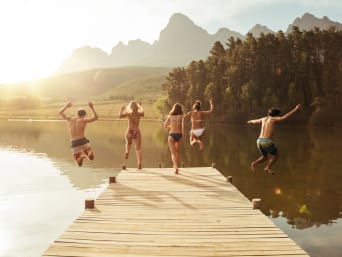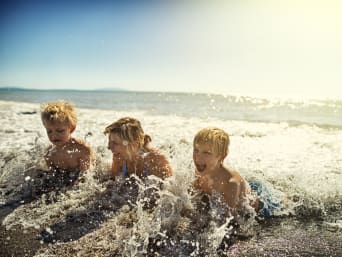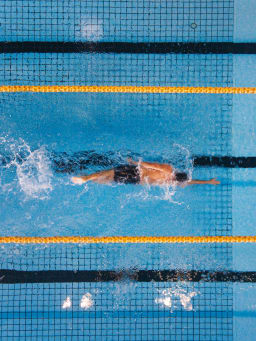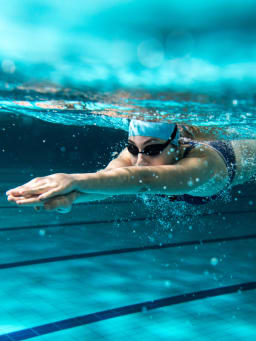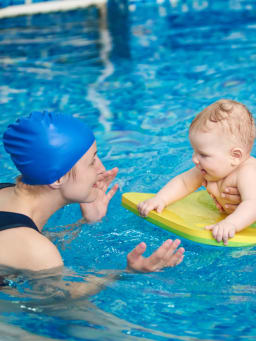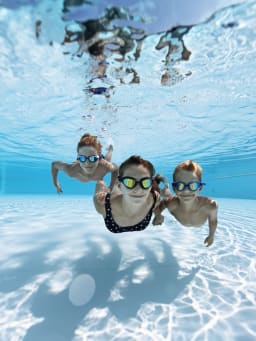Swimming in open waters – How to safely swim in the sea, lakes, and rivers
On hot summer days, an increasing number of people are drawn to local lakes, and the sea also remains a popular destination for excursions and holidays. As tempting as cooling off may be, there are nevertheless some safety aspects to consider when swimming in open waters. Observing swimming rules saves lives. This article provides general safety tips for swimming in open waters, provides information about special risks when swimming with children and explains what to do in the event of an emergency.
General safety tips
Different waters also pose different risks. Swimming in open waters such as oceans, lakes or rivers poses a completely different challenge than the supervised and heated pool in your local swimming pool. The lower water temperatures in open waters rob the body of energy. Often, people misjudge their own strength. In addition to the general swimming rules, you should therefore observe some further safety rules to ensure that swimming in open waters remains safe.
Only swim in guarded swimming areas
Pay strict attention to the signposts there. They will inform you in detail about potential risks on the beach. Experts on site (e.g. lifeguards) also provide information about particular dangers and emergency call facilities.
Always comply with swimming bans.
If you are heated by the sun, have a short rest before going into the water. When possible, take a shower before swimming. Enter the water slowly to help your body to acclimatise to colder water temperature.
Even if it has been very hot for several days in a row, typically only the surface of the water will have a pleasantly warm temperature. Deep waters such as quarry ponds are still cold. This can lead to hypothermia and result in dangerous cramps.
Evaluate your own performance critically and know your limits.
Never jump into unknown waters. Head dives at shallow water and shoreline areas can be life-threatening. Only jump into the water at the marked jumping spots.
Never swim where boats and ships are sailing.
Do not enter the water directly after eating. Also, do not drink alcohol if you wish to go swimming.
Leave the water and the beach immediately during a thunderstorm.
Not only for swimming, but also for the various water sports on the water, some safety aspects should be observed. Mutual respect among water sports fans is essential. Furthermore, you should make sure that you behave in an environmentally conscious manner in open waters.
Currents - The invisible danger
One of the biggest dangers to swimming in the sea or in open waters is currents - even for experienced swimmers. Especially on the coast, tides or wind cause a constant change in the direction and strength of the current. If you get caught in a current, stay calm and always swim diagonally to the current. Follow the direction of the current, even if it makes the path longer. This is the best way to free yourself from the whirlpool and swim to the safe shore.
Particular risks of swimming in river
Especially in rivers, you must be prepared for the often unpredictable force of the current. In addition to the water level, shallows, channels, and bridge piers affect the currents. This is how a suction action can develop. Flotsam and invisible obstacles under water pose an additional risk. Furthermore, rivers usually have significantly lower temperatures than lakes because they warm up more slowly. Therefore, hypothermia can also occur more quickly.
You should swim in the river only if you are an experienced swimmer. Beginners should avoid swimming in rivers at all costs. Waterways, bridge piers, weirs, groynes, and locks are not swimming areas. Anyone who decides to swim in these areas may be subject to a fine.
Special challenges of swimming in standing waters
Swimming in standing waters such as ponds or lakes can be a lot of fun, but sometimes it also involves risks. Potential dangers arise from steeply sloping banks, swampy substrates, or water plants. In gravel pits and quarry lakes, it is also possible for the shore to slip. To avoid accidents, you can find out about the special features of the water body in advance from local experts.
In standing waters, long, ribbon-like plants often grow just above the water surface. If you are surprised by them, the shock can often lead to panic. Stay calm if you become entangled with such plants and alert other swimmers by shouting. Avoid swimming in plant-infested waters if possible.
Important swimming safety rules in the sea
In general, coastal waters are riskier for bathing and swimming than inland waters. The seabed is constantly changing, so the situation and environment is often more difficult to assess for swimmers. This is how sandbanks are formed, for example, and then disappear again after a short time and form water depths. In addition, there is wind, current and the direct influence of the weather. Shifting winds can cause a strong swell within a few minutes and become threatening even for experienced swimmers. Swimming in the sea requires much more strength and body control than in the calm waters of a swimming pool.
Therefore, always pay attention to the flags and the signs on the beach. Windsocks also give you important information for your safety. They indicate whether the wind is blowing from the land towards the sea. Air mattresses, but also swimmers themselves, will then quickly drift into the open sea. When abroad, ask the hotel staff, tour guide or lifeguard about the local conditions and potential dangers.
What do beach flags mean
To inform beach visitors and swimmers about current risks in the water, many water lifeguard stations use a standardised flag system that has been standardised worldwide by the ISO (International Organization for Standardization).
Red-yellow flag: the beach area is safe and supervised by lifeguards. If the flag is directly on the beach line, two flags often limit the permitted swimming area. Outside the boundary, bathing is then prohibited.
Yellow flag: this flag indicates a warning. Pay special attention to loudspeaker announcements and to up-to-date information from the lifeguards. Only confident swimmers should venture out into the water at this time.
Red flag: swimming and bathing are strictly prohibited.
Black and white chequered flag: restricts the area for water sports equipment, bathing is prohibited here.
Blue Flag: "Seal of approval" for particularly environmentally friendly and safe beaches.
Sea urchins, jellyfish & others - Beware of sea creatures when swimming
Sea urchins live on almost all seacoasts. Their brittle spines break easily and can cause injuries. If you wish to swim in coastal waters, you should wear bathing shoes with a firm sole. They also offer protection from broken fragments and sharp objects.
However, swimming shoes can do little against jellyfish. Even though jellyfish are not life-threatening in local waters and in the Mediterranean, touching them causes an unpleasant burning sensation. Many jellyfish species in tropical waters, such as the cube jellyfish, on the other hand, are highly poisonous and may lead to threatening paralysis if touched. Do not swim in waters where jellyfish are lying on the beach. Always take swimming prohibitions seriously, even if you don't see any jellyfish yourself. In addition to warnings about jellyfish, shark alerts may occasionally be issued in some swimming areas.
Water safety tips for children
Most children are fascinated by water - children have a lot of fun splashing around and swimming. However, they should never be left unattended when swimming. It is your responsibility as a parent to assess the situation and potential risks for your child.
Above all, always make sure that your child's current health condition allows bathing and swimming. Even if there is a swimming supervisor on site, the duty of active supervision always remains with the parents. Don't just rely on the lifeguards! Especially on busy beaches, even trained staff cannot always recognise every emergency immediately. Older siblings are also not suitable supervisors around and in the water.
Get an overview of the potential risks of the waters and the local conditions beforehand. Explain to your child exactly what is allowed and what is prohibited. Prohibitions do not guarantee safety. Talk to your child regularly about the most important safety measures and rules of conduct. Especially with younger children, repeating the rules consistently is more memorable than one-off instructions. Before swimming, ask your child to explain again which rules must be observed. Think about it together so that no rule is forgotten.The most important safety tips and swimming rules for children are summarised below:
Do not let your child swim or splash in unknown waters.
Children should only swim when accompanied by an adult.
Always keep an eye on small children in the water. Always stay within reach.
Before swimming, your child should cool down carefully and gradually.
Take freezing children out of the water immediately.
Observe the designated bathing areas.
Let your child jump into the water only when you are sure that the water is deep enough, and the area is clear.
Accompany older children into the water first on every swimming day and decide together how far they are allowed to go in.
Never let especially small children stand with their backs to the water in the surf area. They can easily be knocked over and get their heads under the water.
Keep plenty of mineral water at hand! Salty seawater draws a lot of fluid from the body. Drinking regularly compensates for the high fluid loss.
As a rule, the earlier your child becomes familiar with safe water handling, the better. Swimming lessons for children already teach them the most important general swimming rules.
Tips for using water toys
Whether flowing or standing water, inflatable toys such as tyres, balls, air mattresses and water animals are not safe aids for swimming. They can even easily become a hazard. When playing, children can fall into water that is too deep or drift off, especially in strong winds. When falling from an air mattress into the water, the risk of cold shock also exists. Even water wings or swimming belts do not offer 100 percent protection. They often lose air unnoticed or are not attached tightly enough.
What to do in an event of emergency?
As a rule, drowning victims cannot call for help. Especially in murky natural waters, every second counts. If you see another swimmer in distress, never run into the water without thinking or alone. Instead, scream loudly for help so that other swimmers can help you and make an emergency call. If a drowning victim has been rescued, first aid measures should start immediately. If the victim is still breathing, place them in the recovery position and keep them warm until the rescuers arrive. If the victim stops breathing, start CPR immediately. Do not wait for the emergency services to arrive and do not try to remove water from the airways first.
Summary
When swimming in open waters, it is important to have at least a basic knowledge of first aid in order to be able to react quickly and correctly in an emergency. Adhering to the safety rules when bathing and swimming also minimises the risk of accidents considerably. Always keep an eye on young children, especially when they are playing in or around the water. Avoid deserted or secluded beaches or lakes and make sure you have good mobile phone reception in case you need to make an emergency call. The emergency number in all European countries is 112. If you are not sure whether it is safe to swim, it is better to avoid swimming at this location and find a safer place to swim.
______________________________________________
References:
https://gwrymca.org/blog/water-safety-tips
(Accessed on 08.02.2022)
https://www.surfertoday.com/surfing/the-complete-list-of-beach-flags-and-warning-signals
(Accessed on 08.02.2022)
https://www.swimming.org/openwater/how-to-stay-safe/
(Accessed on 08.02.2022)
https://safety.lovetoknow.com/Water_Wings_Safety
(Accessed on 08.02.2022)
https://www.webmd.com/first-aid/drowning-treatment
(Accessed on 08.02.2022)
Images sources:
iStock.com/jacoblund
iStock.com/stockstudioX
iStock.com/Gwengoat
iStock.com/Imgorthand
